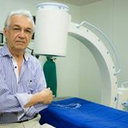Use of a gel biopolymer for the treatment of eviscerated eyes: experimental model in rabbits.
Keywords
Abstract
OBJECTIVE
To evaluate histologically the integration process of cellulose gel produced by Zoogloea sp when implanted into rabbits' eviscerated eyes.
METHODS
This experimental study employed 36 eyes of 18 rabbits subjected to evisceration of their right eyes. The sclerocorneal bag was sutured and filled with biopolymer from sugar cane in the gel state. All animals were clinically examined by biomicroscopy until the day of their sacrifice which occurred on the 7th, 30th, 60th, 90th, 120th, or 240th day. The eyeballs obtained, including the left eyes considered controls were sent for histopathological study by optical macroscopy and microscopy. Tissue staining techniques used included hematoxylin-eosin, Masson trichrome (with aniline), Gomori trichrome, Van Gienson, Picrosirius red, and periodic acid-Schiff (PAS).
RESULTS
No clinical signs of infection, allergy, toxicity, or extrusion were observed throughout the experiment. The corneas were relatively preserved. Macroscopic examination revealed a decrease of ~ 8% in the volume of the bulbs implanted with the biopolymer. After cutting, the sclerocorneal bag was solid, compact, elastic, and resistant to traction, with a smooth and whitish surface, and showed no signs of necrosis or liquefaction. The episcleral tissues were somewhat hypertrophied. The histological preparations studied in different colors revealed an initial lymphoplasmacytic infiltration, replaced by a fibroblastic response and proliferation of histiocytes, along with formation of giant cells. Few polymorphonuclearneutrophils and eosinophils were also found. Neovascularization and collagen deposition were present in all animals starting from day 30; although on the 240th day of the experiment the chronic inflammatory response, neovascularization and collagen deposition had not yet reached the center of the implant.
CONCLUSIONS
In this model, the cellulose gel produced by Zoogloea sp proved to be biocompatible and integrated into the orbits. Morphometric, immunohistochemical and biodegradability studies should be performed in the future.


